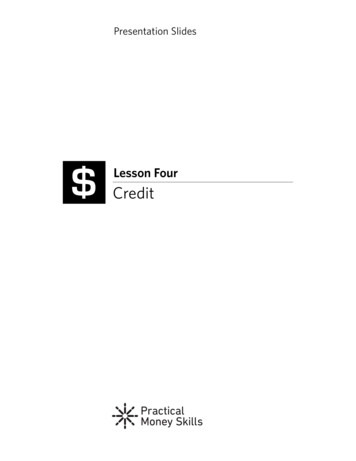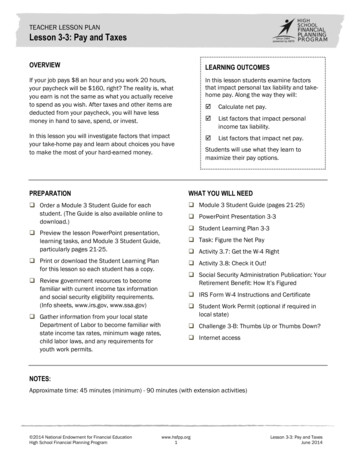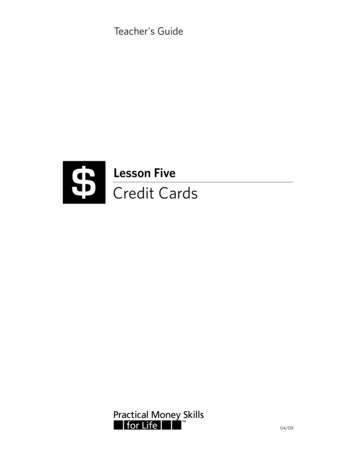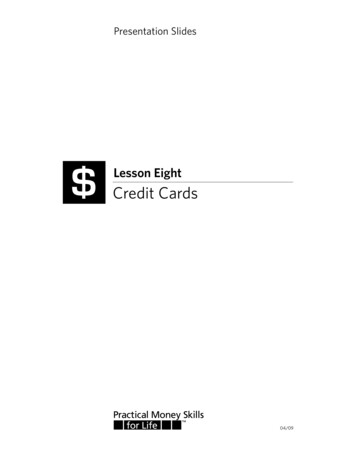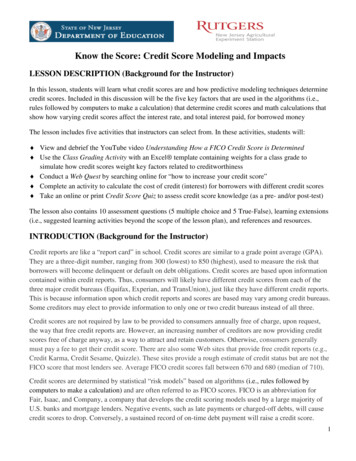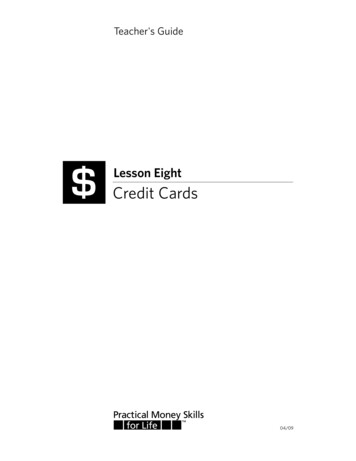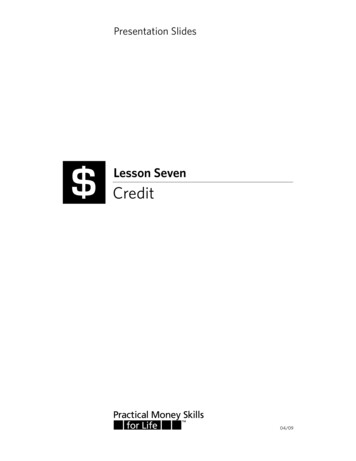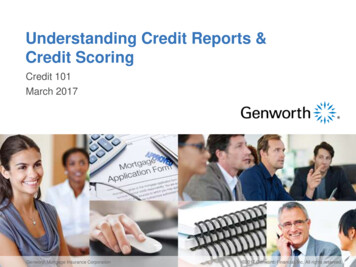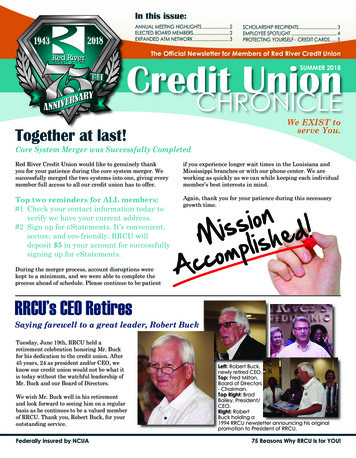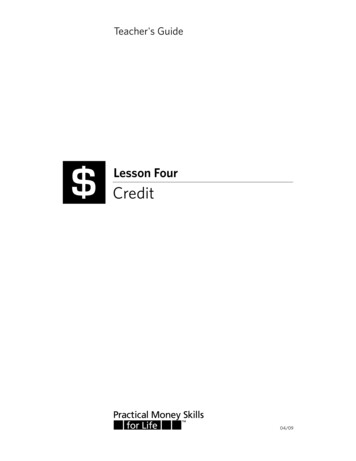
Transcription
Teacher's Guide Lesson FourCredit04/09
credit websitesConsumers may use credit frequently, but many struggle to manage it wisely. Tooptimize credit and make sound financial decisions, students need to: understandtheir credit; assess their credit scores; and manage their budget.For related links and resources on this lesson, calmoneyskills.com creditteacher's guide 4-i
credit lesson outlineoverviewIn today's world, credit is integrated into everyday life. From renting a car to reserving an airlineticket or hotel room, credit cards have become a necessary convenience. However, using creditwisely is critical to building a solid credit history and maintaining fiscal fitness. While moststudents have a general idea about the advantages and disadvantages of credit, this lessonprovides an opportunity to discuss these issues in more detail.Young people and others commonly wonder how to establish credit. In this chapter, studentswill learn about the creditworthiness factors of character, capital, and capacity in order to helpthem gain an understanding of how to start and maintain a credit record.This chapter will also introduce students to different types of credit: single-payment credit,installment credit, and revolving credit. Finally, this section will educate students about howmuch credit might be appropriate for their situation.goalsProvide an awareness and understanding of what credit is and the rights and responsibilities ofusing credit.lesson objectives Understand some of the reasons for getting credit Understand some of the advantages and disadvantages of using credit Understand why banks issue credit List and understand some of your rights and responsibilities as a consumer Understand creditworthiness List some of the reasons for establishing a credit history and understand how a credithistory is built List and understand the three principal types of consumer credit Determine a safe debt loadpresentation slides4-Aadvantages and disadvantages of using credit4-Bthe three Cs4-Cyour responsibilities4-Dyour rights4-Ebuilding a credit history4-Fa credit reportwww.practicalmoneyskills.com creditteacher's guide 4-ii
credit lesson outline4-Gmanner of payment codes4-Htypes and sources of credit4-Ihow much can you afford (the 20-10 rule)student activities4-1Should They Use Credit?4-2Test Your Credit Knowledge 4-3How Much Can They Safely Carry? 4-4 Distribute the test and give students approximately 15 minutes to complete it. Whenthey are finished, discuss their answers. Reinforce facts and concepts of credit. Students plan and calculate safe debt loads for other consumers. Distribute the exercise, giving students about 20 minutes to complete it. When theyare finished, discuss the answers, writing their calculations on the board.Lesson Four QuizFor more information, please refer to the Appendix.www.practicalmoneyskills.com creditteacher's guide 4-iii
credit lesson outlineLearning activities appropriate to varied target audiences for lesson fouractivityteenagers(14-18)young adults(19-25)adults(26 )Student Activity 4-1Web ActivityOral PresentationStudent Activity 4-2Student Activity 4-3Lesson Four Quiz 4-4www.practicalmoneyskills.com creditteacher's guide 4-iv
credit teaching noteswhat is consumer credit?1.Definition2.Brief historywhy get credit?1.Establish a credit history2.Advantages of having credit 3. Buyingneeded or wanted services and goods usinganticipated future income Havinga record of purchases Consolidating billsDisadvantages of having credit discussionstudent activity 4-1slide 4-A Interestpayments Overspending becomes too easy Financialtrouble may arise if card is not managedproperlywhy banks issue credit1.To make money2.discussiondiscussionTo offer service to acitydiscussionstudent activity 4-2slide 4-Bwww.practicalmoneyskills.com creditteacher's guide 4-v
credit teaching notesyour responsibilities1. Not to run up more debt than you can comfortably repay2.Not to exceed the credit limit established by your creditor3. ot to re-sell merchandise before completely paying theNcreditor, if the creditor has retained the title or has alien against itdiscussionslide 4-C4. To notify the creditor immediately if your credit card islost or stolenyour rights1.Truth in Lending Act2.Fair Credit Reporting Act3.Equal Opportunity Act4.Fair Credit Billing Act5.Fair Debt Collection Practices Act6.State Statutesdiscussionslide 4-D Restricting the amount of interest that can becharged (usury laws) To obtain more extensive information www.practicalmoneyskills.com creditteacher's guide 4-vi
credit teaching notesbuilding a credit history1.Credit bureaus—what they are and how they work2.How to establish a good credit history Pay bills on timeGet a low-limit credit card or other loan and paybills promptlydiscussionweb activity:Have students visit oneor more of the websitesof major credit ion.comslide 4-Ea credit report1.What a credit report covers and what it looks like Identification and employment data Payment history Inquiries Public record information2.Credit scoring, manner of payment codes How you can get a black mark What creditors look for—the three Cs3.4.5.What to do if you have a bad credit reportoral presentationHave students present inclass (or on video) severalpositive and negativeactions that would affecta person’s credit history.slides 4-F & 4-GHow time affects your credit reportHow to handle mistakeswww.practicalmoneyskills.com creditteacher's guide 4-vii
credit teaching notestypes of credit1.Noninstallment credit Regular 30-day charge accounts Travel and entertainment cards How to use and best time to use(paid off every month)2.Regular installment credit Car loan How to use and best time to use3.Revolving credit Department store cards Bank cards How to use and best time to usediscussiontest your credit knowledge1.Multiple choice, fill-in-the-blank, and matching teststudent activity 4-2how much can you afford?1.The 20-10 rule What it means Examples2.Exercisesslide 4-Hdiscussionstudent activity 4-3slide 4-Ilesson four quizwww.practicalmoneyskills.com creditquiz 4-4teacher's guide 4-viii
should they use credit?answer keydirectionsFor each of the following situations, circle YES, NO, or DEPENDS to indicate your opinion onwhether these people should use credit. Also, give reasons for your response.Answers may vary1: Marge, age 18, plans to buy a car on credit so that she is able to drive to school.YESNO2: Fran and Bud recently took out a loan for a new roof.YESNODEPENDSDEPENDS3: Edgar, age 20, recently used his credit card to pay for textbooks for his new semester of classes.YESNO4: Marcia, age 28, charges all her groceries on her credit card.YESNODEPENDSDEPENDS5: Sandy and Carla, age 24 and 27, are planning on buying a boat on credit for use duringsummers. Carla will be the main signer for the loan, with Sandy being the co-signer.YESwww.practicalmoneyskills.com creditNODEPENDSstudent activity key 4-1
test your credit knowledgeanswer keyThe following questions are designed to help you remember the credit information just coveredin class.directionsIn the spaces provided, answer each of the following questions about credit:List five things you can do to build a credit history.1. Establish a steady work record.2. Pay all bills promptly.3. Open a checking account and don’t bounce checks.4. Open a savings account and make regular monthly deposits.5. Apply for a small loan using your savings account for collateral and then pay it back as agreed.6. Get a co-signer for a loan and pay back the loan as agreed.When a prospective creditor evaluates a credit application, they look for the three Cs: Character,Capital, and Capacity. For each of the following statements, write the letter that corresponds toeach statement’s specific characteristic.a) Character b) Capital7. b8. a9. a11. c12. a13. cc) CapacityDo you have a savings account?Have you used credit before?How long have you lived at your present address?Do you have a steady job?Do you pay your bills on time?What are your current debts and your current living expenses?List four things you can do to build a credit history.Any of these answers are correct: Establish a steady work record. Pay all bills promptly. Open a checking account and don't bounce checks. Open a savings account and make regular deposits. Apply for a local store credit card and make regular monthly payments. Apply for a small loan using your savings account as collateral. Get a co-signer on a loan and pay back the loan as agreed.www.practicalmoneyskills.com creditstudent activity key 4-2
test your credit knowledge answer keyIn the space provided, write the letter of the type of credit eachstatement represents.a) Single payment credit14. b15. a16. a17. c18. ab) Installment creditc) Revolving creditMonthly payment on a car loanMonthly telephone billMonthly heating billUsing a credit card to buy a new jacket from a department store and then paying thecharge off over several monthsUsing a major credit card to buy a pair of shoes and then paying the total amount ofthe credit card balance within a monthFor each of the following statements, write a T in the space provided if the statement is true, andF in the space provided if the statement is false.f19.It is legal for a creditor to deny an applicant credit based on marital status or age.20. f21. tIf you are denied credit, the creditor is not legally obligated to explain why.22. tIf you are refused credit because of a credit report, upon request from you, the lendermust give you the name and address of the credit bureau that issued the report.23.f24.f25. tWhen creditors evaluate your income, they can’t legally refuse to consider incomefrom public assistance in the same manner as other income.Your credit report is available to anyone, regardless of the reason.A debt collector has the right to contact you at any time of day or night.To be within a safe debt load, your total credit should not exceed 20% of your net payafter subtracting rent.26. What should you do if you find there is inaccurate information on your credit report?Contact the credit bureau. Under the Fair Credit Reporting Act, the credit bureau must investigateyour report.27. Generally, how long can a consumer reporting agency report unfavorable information?7 years38. How long can bankruptcy information be reported by a consumer reporting agency?Up to 10 yearswww.practicalmoneyskills.com creditstudent activity key 4-2
how much can they safely carry?answer keyMost people can afford a certain amount of credit and stay within a safe budget. This amount iscalled a “safe debt load.” The following exercises will give you practice determining safe debt loadsbased on various incomes and fixed expenses.directionsRead each of the following scenarios and determine the largest amount of debt each person cansafely carry. Write your answers in the blanks provided. Use the space below each question to show howyou arrived at each answer.1. David has a monthly net income of 1,360. His fixed monthly expenses consist of a rentpayment of 450. He is paying off a student loan of 116 per month.David would like to buy a new television set using a credit card. What is the largest monthlypayment David can afford for the television set so that his credit card payments and student loankeep him within a safe debt load of 20%? 20.00 1,360 x 10% 136 136 - 116 202. Marsha and Michael have a combined monthly net income of 3,500. Their fixed monthlyexpenses consist of 675 for rent. They also have an outstanding student loan balance of 6,000and a balance of 1,000 for the stereo they bought last month.How much more debt can they take on and still be within a safe debt load? 1,400.00 3,500 x 12 42,000 42,000 x 20% 8,400 8,400 - 6,000 - 1,000 1,4003. Juanita has a monthly net income of 2,500. Her fixed monthly expenses consist of 500 forrent. She also pays a car insurance premium of 68 and a car payment of 167. Are thesepayments within Juanita’s safe debt load?Yes 2,500 x 10% 250 250 - 167 - 68 15www.practicalmoneyskills.com creditstudent activity key 4-3
lesson four quiz: about creditanswer keytrue-falsetA disadvantage of using credit is impulse buying.1. 2.t3.t4.f5.tCapital refers to a person’s assets.A steady employment record helps a person’s credit history.Installment credit usually allows a person to make additional purchases on an account.Using the 20-10 rule, a person making 40,000 a year after taxes should have no morethan 8,000 of outstanding debt.multiple choiceCA common advantage of using6. credit is:A. less impulse buyingB. lower cost for items purchasedC. ability to obtain neededitems nowD. lower chance of overspendingD A person’s regular income is7. referred to as:A. characterB. capitalC. collateralD. capacityA8. To build a credit history, aperson could:A. establish a steadyemployment recordB. file his or her federal incometaxes on timeC. use an ATM several timesa monthD. request to view her or hiscredit fileB9. Utility companies and medicalservice organizations commonlyoffer credit.A. revolvingB. single-paymentC. installmentD. retailA10. Using the 20-10 rule, a person earning 1,500 a month should not havemonthly credit payments that exceed:A. 300B. 150C. 20D. 30case applicationAna Gonzalez is considering a loan to finance her college education. She currently owes money onseveral charge accounts and credit cards. What actions would you recommend? While this is a validreason for using credit, Ana might consider paying off some of her other debts before taking on this newloan. She might delay starting school full time until she has paid off her other accounts.www.practicalmoneyskills.com creditquiz key 4-4
www.practicalmoneyskills.com credit teacher's guide 4-i Consumers may use credit frequently, but many struggle to manage it wisely. To optimize credit and make sound financial decisions, students need to: understand their credit; assess their credit scores; and manage their budge
